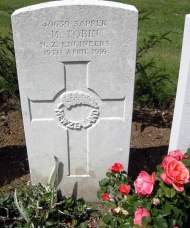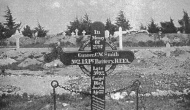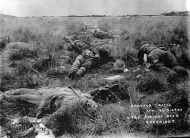Articles
First World War - overview

Archduke Franz Ferdinand, heir to the throne of the Austro-Hungarian Empire, and his wife Sophie were assassinated in the Bosnian city of Sarajevo. This was a key event in sparking the Great War of 1914–18.
-
Page 5 – The war at home
New Zealand played a small but useful part in the British Empire's war effort, and its essential war aim was achieved with the defeat of Germany and its allies in late 1918.
Battle of the Somme

A truly nightmarish world greeted the New Zealand Division when it joined the Battle of the Somme in mid-September 1916. Fifteen thousand men of the Division went into action. Nearly 6000 were wounded and 2000 lost their lives. More than half the New Zealand Somme dead have no known grave.
-
Page 2 – Overview
'Somme. The whole history of the world cannot contain a more gruesome word.' This is how one German officer described the Battle of the Somme in 1916. It was here that, day
-
Page 3 – New Zealand's Somme experience
It was on the Somme that the majority of New Zealanders were killed or wounded during the First World War, and it was here that New Zealand experienced its worst days in
-
Page 5 – New Zealand artillery on the Somme
Halfway through the Great War, the big guns roared into life along the New Zealand Division's sector on the Somme in support of a major attack on 15 September 1916.
Passchendaele: fighting for Belgium

Ever since 1917 Passchendaele has been a byword for the horror of the First World War. The assault on this tiny Belgian village cost the lives of thousands of New Zealand soldiers. But its impact reached far beyond the battlefield, leaving deep scars on many New Zealand communities and families.
-
Page 3 – The Passchendaele offensive
The failed attempt to capture the town of Passchendaele saw more New Zealanders killed in one day than in any other military campaign since 1840.
-
Page 5 – The human impact

One in four New Zealand men aged 20–45 was either killed or wounded in the First World War, but the impact of the war reached far beyond these individuals and directly affected
-
Page 7 – Helping the wounded
More than 14,000 New Zealanders were wounded between June and December 1917 in Belgium, and medical staff, orderlies, chaplains and stretcher-bearers worked round the clock to
-
Page 8 – Remembering the dead
Just under 100 war cemeteries in Belgium and around 500 memorials in New Zealand serve as permanent reminders of the terrible toll of 1917.
Passchendaele activities

NCEA2 activities relating to New Zealand's role in the fight for Belgium during the First World War
- Page 3 - Remembering the deadAcknowledging the sacrifices of those who served or died was an important way for communities, including schools, to make sense of the human cost of
The Merchant Navy

3 September is Merchant Navy Day, which was first officially commemorated in New Zealand in 2010. The date marks the sinking of the first Allied merchant ship in 1939, just hours after the Second World War began. This is the story of the 'fourth service' at war.
- Page 6 - Roll of Honour, 1939-45This roll lists the names of seafarers who died while serving on New Zealand merchant ships and New Zealanders known to have been lost while sailing under the flags of other
Merchant marine

On 3 September New Zealand honours Merchant Navy Day. Here we explore the little-known but vital role played by the merchant marine during the First World War, when these civilian seafarers often found themselves in the front line of the war at sea.
-
Page 6 – Agony on the Aparima
One of the worst losses of New Zealand lives at sea occurred on the Union Company’s Aparima in 1917.
The Gallipoli campaign

Each year on Anzac Day, New Zealanders (and Australians) mark the anniversary of the Gallipoli landings of 25 April 1915. On that day, thousands of young men, far from their homes, stormed the beaches on the Gallipoli Peninsula in what is now Turkey.
- Page 6 - EvacuationHill 60 was the last major Allied attack at Gallipoli. The failure of the August offensive raised more questions about the future of the campaign, especially in light of the
Hospital ships

The Maheno and Marama were the poster ships of New Zealand's First World War effort. Until 1915 these steamers had carried passengers on the Tasman route. But as casualties mounted at Gallipoli, the government - helped by a massive public fundraising campaign - converted them into state-of-the-art floating hospitals.
-
Page 6 – Later service and legacies
The Marama missed Gallipoli, reaching the Mediterranean a few weeks after the Allies abandoned the peninsula. The ships’ service pattern would now be dominated by long voyages
Featherston camp

History of the military training camp at Featherston during the First World War
- Page 2 - Featherston camp death register 1915–19A transcript of the Featherston Camp death register from the First World
Western Front in 1918

In 1918, a series of major German and Allied offensives broke the stalemate of trench warfare on the Western Front, resulting in the collapse of the German Army and the end of the war within the year. New Zealand units played an important part in the Allies' final push for victory.
- Page 1 - 1918: Amiens, Bapaume and victory - Western Front campaignIn 1918, a series of major German and Allied offensives broke the stalemate of trench warfare on the Western Front, resulting in the collapse of the German Army and the end of the
Korean War

New Zealand was involved militarily in Korea from 1950 to 1957, first as part of the United Nations 'police action' to repel North Korea's invasion of its southern neighbour, and then in a garrison role after the armistice in July 1953.
- Page 8 - Korean War Roll of HonourRoll of Honour for all New Zealanders killed during the Korean War,
Schools and the First World War

Schools and children were quickly called into action at the outset of the First World War in 1914. Developing patriotic, fit and healthy citizens was seen as important to the survival of the country and the Empire. Hundreds of teachers joined the NZEF, including many from sole-teacher schools. Almost 200 never returned.
- Page 8 - Education service First World War fatalitiesRoll of honour for education service employees killed in the First World
Related keywords
- WW1
- gallipoli campaign
- maheno (hospital ship)
- hospital ships
- horses
- camel corps
- sinai campaign
- disease
- food
- doctors
- chunuk bair
- armistice
- turkey
- death
- marama
- battle of the somme
- health
- prisoners of war
- passchendaele offensive
- memorials
- commonwealth war graves commission
- WW1 maps
- cemeteries
- western front
- battle of bapaume
- le quesnoy liberation
- german army
- united states
- british army
- french army
- weapons
- victoria cross
- germany
- shipping
- WW2
- royal new zealand navy
- hmnzs leander
- palestine campaign
- egypt
- merchant marine
- education
- roll of honour
- korean war
- cold war
- 1950s
- featherston
- training camps
- arras
- tunnelling
- allies
- ottoman army
- shipwrecks
- united kingdom
- artillery
- funerals
- religion
- taranaki
- new zealand wars
- battle of waireka
- merchant navy
- seafarers
- trenches
- nurses
- maori in war
- battle for crete
- south african war
- boer war
- pacific war
- war memorials
- belgium
- railways
- american forces
- NZ Wars memorial
- battle of mahoetahi
- wellington mounted rifles
- letters
- WW1 home front
- british empire
- conscription
- conscientious objection
- wellington college
- wellington cenotaph
- WW1 stories
- air transport
- wellington city
- all blacks
- david gallaher
- families
- donald brown
- national war memorial
- battle of messines
- battle of verdun
- alex mccoll
- paratroops
- anzac
- lemnos
- canterbury mounted rifles
- polderhoek attack
- national identity
- ormond burtonn
-
Main image: Performing field surgery at Gallipoli
Field surgery in progress at a Casualty Clearing Station on Gallipoli
































